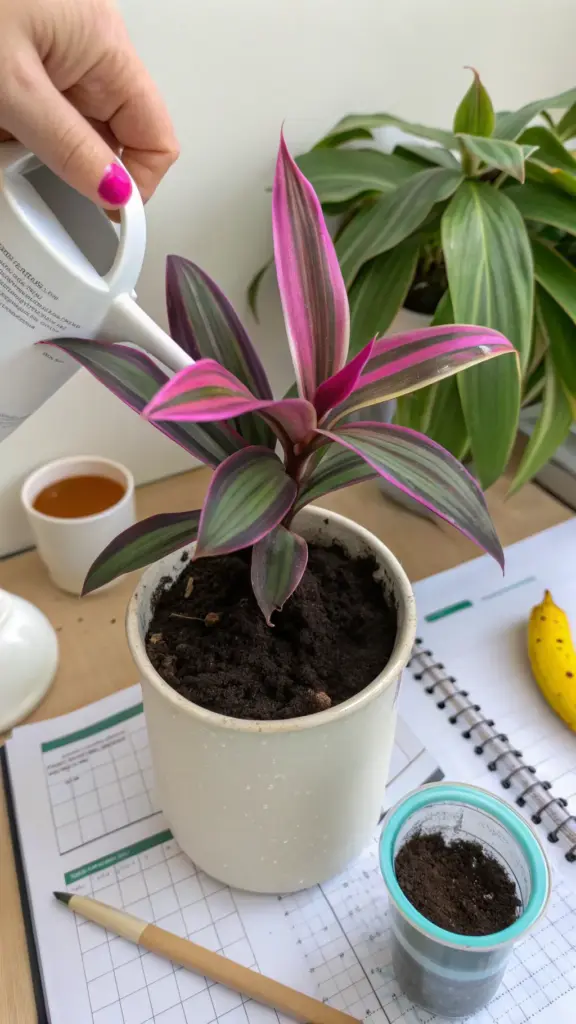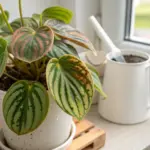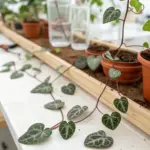4. Fertilizer Formulas That Boost Natural Pigments

I used to think more fertilizer meant better colors. Boy, was I wrong. My first Nanouk turned into this lush, green monster with barely any pink after I started feeding it weekly with standard houseplant fertilizer.
It took me months to figure out that high-nitrogen fertilizers were literally stealing my plant’s gorgeous colors.
That expensive pink beauty looked like any regular green Tradescantia you’d find at a gas station. I was heartbroken.
The Low-Nitrogen Revolution That Saved My Colors
Here’s what nobody tells you: nitrogen promotes chlorophyll production, which masks those beautiful anthocyanin pigments we’re all obsessing over. More nitrogen equals more green, less pink.
I switched to a fertilizer with an NPK ratio of 3-10-10 and watched my plant transform over six weeks. Those pink stripes came back stronger than ever.
Low-nitrogen feeding feels counterintuitive because we’re taught that nitrogen makes plants grow. But for color enhancement, less is definitely more.
I now use fertilizers with nitrogen levels below 5% during peak growing season. The difference is absolutely stunning.
The Magic Phosphorus and Potassium Formula
Phosphorus became my secret weapon for pigment production. It helps plants create and maintain those gorgeous pink and purple compounds we love so much.
Potassium is the unsung hero for overall plant health and color stability. It helps transport nutrients and water throughout the plant, keeping colors vibrant and consistent.
My go-to ratio is 2-10-10 or 3-12-12 during growing season. The higher phosphorus and potassium levels support anthocyanin development without overwhelming the plant with green-producing nitrogen.
Bloom booster fertilizers work amazingly well for Nanouk colors because they’re designed with this exact nutrient profile.
Organic vs Synthetic: The Color Showdown
I tested organic fertilizers against synthetic ones for eight months with identical Nanouk cuttings. The results surprised me.
Fish emulsion and kelp meal gave me the most consistent, long-lasting colors. The slow nutrient release prevents those dramatic green flushes that synthetic fertilizers can cause.
Synthetic fertilizers work faster but require more careful timing. One heavy feeding can turn your pink beauty green for months.
Compost tea became my favorite organic option. I brew it weekly and dilute it heavily – the gentle, consistent feeding keeps colors stable.
Timing Your Feeds for Maximum Color Impact
Spring feeding starts light when I see new growth emerging. I use quarter-strength fertilizer every two weeks until the plant is actively growing.
Summer is prime color season – I feed every 3-4 weeks with my low-nitrogen formula. This supports growth without overwhelming the pigment production.
Fall feeding tapers off gradually. I stop fertilizing about 6 weeks before my area’s first frost to help the plant prepare for dormancy.
Winter feeding is basically non-existent. Maybe once if the plant is still showing active growth, but usually I let it rest completely.
DIY Fertilizer Recipes That Actually Work
My banana peel fertilizer became legendary among my plant friends. I soak chopped banana peels in water for 48 hours, then dilute the liquid 1:10 for a potassium-rich feed.
Coffee grounds mixed with eggshells create a slow-release fertilizer perfect for color enhancement. The coffee provides gentle nitrogen while eggshells add calcium.
Epsom salt solution (1 teaspoon per gallon) once monthly gives plants the magnesium they need for chlorophyll production without overdoing nitrogen.
I make compost tea by steeping a handful of finished compost in a gallon of water for 24 hours. It’s like plant vitamins – gentle but effective.
Over-Fertilization Warning Signs I Learned the Hard Way
Rapid green growth with fading colors is the biggest red flag. When my Nanouk started growing like crazy but losing its pink, I knew I’d overdone the nitrogen.
Salt buildup from synthetic fertilizers shows up as white crusty deposits on soil surface. This blocks nutrient absorption and kills colors fast.
Leaf burn appears as brown, crispy edges even when watering is perfect. Too much fertilizer concentration literally burns the plant tissue.
Leggy growth with pale colors means the plant is growing too fast to produce proper pigments. Slow and steady wins the color game.
My Biggest Fertilizer Mistakes (Learn From My Pain)
I once used lawn fertilizer thinking more nitrogen would make my plant healthier. Three months later, it looked like a completely different species – all green, no personality.
Fertilizing during winter when the plant was dormant caused root burn and color loss that took six months to recover from.
Mixing different fertilizers seemed like a good idea until I created a nutrient imbalance that turned my beautiful pink leaves yellow-green.
Daily weak feeding sounded gentle but actually overwhelmed the plant’s ability to process nutrients properly.
The Professional Color-Boosting Schedule
Month 1-2 (Early Spring): Quarter-strength low-nitrogen fertilizer every 3 weeks as growth begins.
Month 3-6 (Peak Season): Half-strength bloom booster every 4 weeks during active growing period.
Month 7-8 (Late Summer): Reduce to every 6 weeks, focusing on potassium-rich feeds to prepare for fall.
Month 9-12 (Fall/Winter): No fertilizer unless plant shows active growth, then very dilute feeding monthly.
Reading Your Plant’s Nutrient Needs
New growth color tells you everything about your fertilizer game. Pink new leaves mean you’re nailing it; green new growth means too much nitrogen.
Older leaves fading while new growth stays colorful is normal. But if everything starts losing color, it’s time to adjust your feeding schedule.
Growth rate should be steady but not explosive. Rapid growth usually means too much nitrogen and compromised color development.
Overall plant health matters more than dramatic colors. A stressed plant won’t maintain vibrant pigments no matter what you feed it.
Your fertilizer game is now on point, but there’s one more pruning technique that can literally double your color impact! Most plant parents are too scared to cut their Nanouk, but strategic pruning actually triggers the most vibrant new growth you’ve ever seen. Click “next” to discover the professional cutting secrets that create fuller, more colorful plants!









GIPHY App Key not set. Please check settings